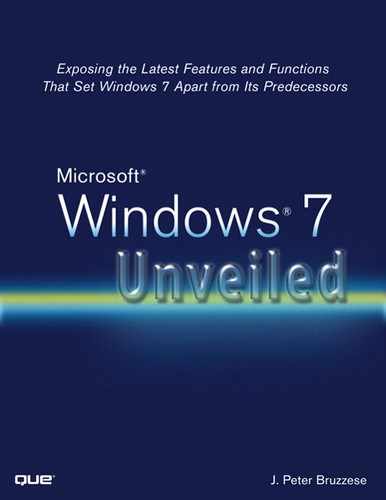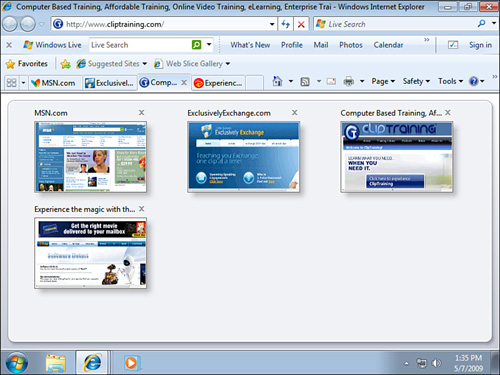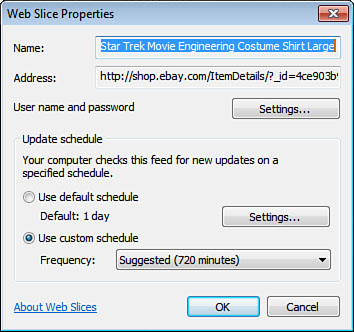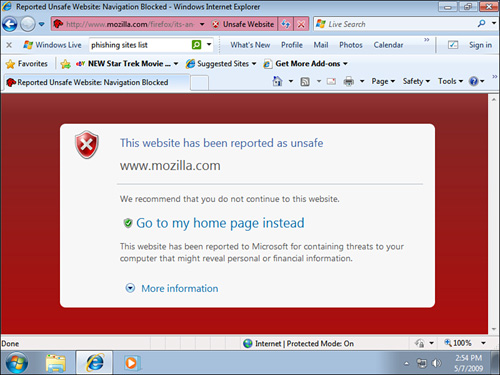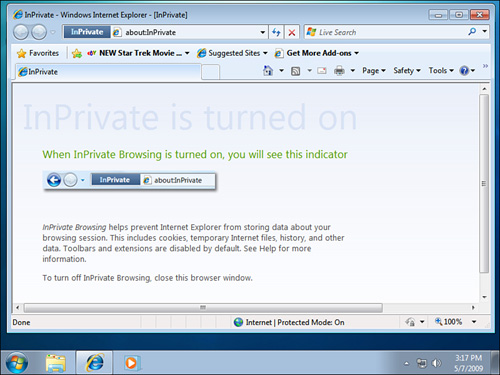IN THIS CHAPTER
Internet Explorer 8 (IE 8) is filled with new features, and this chapter discusses them in detail. Accelerators, Web Slices, InPrivate Browsing, the SmartScreen Filter and more are explored.
Microsoft has been taking a decent loss to Mozilla’s Firefox browser over the past few years. Many would admit that Firefox is the first thing they installed after installing their OS. Internet Explorer 7 (IE 7) was Microsoft’s first shot at redeeming itself, and it did a pretty decent job of that. IE 8 hopes to continue to push through the battle against Firefox, Safari, and newcomer Google Chrome. It’s doubtful any one will be proclaimed the victor. Sometimes it is just a matter of what you are used to.
Note
Even if you are not using Windows 7, you can download IE 8 from the Microsoft site. There is, however, a distinction between IE 8 solo and IE 8 with Windows 7. Windows 7 allows for certain unique features and functionality, such as Windows Touch and jump lists, which you won’t have if you install IE 8 on Windows XP or Windows Vista.
There are features in IE 7 that are present in IE 8, too. For example, one thing IE 7 finally included was tabbed browsing. However, the thing we really like is that there is always a tab waiting for us. (It’s always slightly annoying that Firefox doesn’t have that; however, Google Chrome does.) You can press Ctrl+T in both Firefox and IE 8 to bring up a new tab, but it’s nice to have one already sitting on the tab bar whenever we need it.
Some additional features that carry over from IE 7 include those described in the following sections.
The Quick Tabs feature enables you to see all your open tabs in mini windows (see Figure 4.1). Quick Tabs provides a thumbnail view of your tabs so that you can visually identify which pages you are working with, something that becomes more difficult as you open more tabs.
There is also a button (right next to the Quick Tabs icon) that lists all the tabs you have open, and this is a quick way to see which pages are open (which becomes more difficult with more tabs open because you cannot see all the tabs). Firefox has the same type of button to list tabs, but not a Quick Tabs option, as of the time of this writing.
For your Tab settings, select Tools, Internet Options, and then click the Settings button in the Tabs section.
Carried forward from IE 7, you can open up a collection of tabs and then select an option to Add Current Tabs to Favorites. This allows you to select with one click that group and open all simultaneously.
You can also set up more than one home page to open. To do this, go to Internet, display the General tab, and just type in more than one page. Or you can open the pages you want to have as the home pages and then select the little drop-down option next to the Home icon on your toolbar.
When I open my browser, I like to see my email accounts (Yahoo!, Gmail, and so forth), the news, and a fresh Google site for me to begin my work. In earlier versions of IE, this wasn’t possible to create as “home.” With IE 7, however, and continuing in IE 8, it is a staple feature.
You can also do this without going into your options. You can open the pages you prefer for your home page, select the down-arrow next to the Home icon on the Command Bar toolbar, and then choose Add or Change Home Page. You will be presented with one of three options for the tabs you have open (of which you will no doubt be on one at the time you select the option). Your options are as follows:
• Use This Webpage as Your Only Home Page
• Add This Webpage to Your Home Page Tabs
• Use the Current Tab Set as Your Home Page
Additional improvements from IE 7 include the following:
• Printing settings: In the past, it was frustrating to print certain web pages because the right side of the page was often cut off. Many would copy what they wanted into Word and then print it. You could also change the mode to Landscape and print this way, but that used more paper. However, a Shrink to Fit setting makes sure the page can print on any size paper. You now have a Print Preview window that enables you to manipulate your print settings.
• Search toolbar: To the right of the Address bar is the Search bar. You can choose from various search providers (and add extra ones if you like). An arrow to the right of the Search bar allows you to add additional search providers (for example, a YouTube search).
• Zoom: Zoom is another great feature and enables you to increase the size of both text and graphics of a page. You can increase or decrease using Ctr++/- or return to 100% using Ctrl+0 (zero).
• Supports RSS feeds: RSS feeds are supported and located under the Favorites settings under Feeds. To access feed settings, go to the Feeds and Web Slices section, click the Settings button, and then open Tools, Internet Options, Content. You can easily see whether a site has an RSS feed by looking for the orange square on the Command bar to light up on the when you are on a site with a feed.
Internet Explorer 8 is not a minor upgrade from 7 with a few new bells and whistles. It actually has a bevy of important features that will make our browsing experience more enjoyable and safer.
Consider the following features that are new to IE 8.
Suggested Sites is an online service that uses your browsing history to make personalized website suggestions. It can be turned on or off at any time (the default is off). To turn it on or off, click the Tools button, and then click Suggested Sites.
It might take a while for the browser to collect information about your patterns, but when it has enough information, you can select the Suggested Sites Web Slice off the Favorites bar to locate suggestions. (Web Slices will be discussed shortly.)
Keep in mind that Suggested Sites will not work if you have InPrivate Browsing (discussed in the next section) turned on, because that conflicts with the concept of “private” browsing. It is also disabled if you visit a Secure Sockets Layer (SSL)-secured site. Suggested Sites work by sending your browsing history to Microsoft, where it is compared to related websites.
Note
This feature is something that some are concerned about in relation to their privacy. Microsoft has said it will not store this information, but at the same time the Windows Help and Support information says that even items deleted from your browsing history “will be retained by Microsoft for a period of time to help improve our products and services.” So, it’s a personal choice as to whether you want to enable this new feature.
The term accelerator might make a person think it is an actual technology to speed up Internet use in some way, but that is incorrect. The idea behind “accelerators” (see Figure 4.2) is to enable you to do in one click (or a few) what used to require more user action, perhaps including cutting and pasting and so forth. The tasks include mapping locations, translation of words, and more. So, surfing and finding items might be accelerated, but your speed or the browser performance is not necessarily faster. Also, performance is not hindered by the use of accelerators.
Here’s how it works. You select the text you need, and a little blue accelerator icon displays. You can click the icon to obtain directions, a definition, or a translation or to send the text to email content or search, all with a click or two.
You can also select More Accelerators to go to the Add-Ons Gallery, where you can select other items that may be more in line with what you typically do on the Web.
Note
I went to the Add-Ons Gallery and looked for the IMDB accelerator. I wasn’t sure whether one existed, but I thought I would try. Sure enough, it was there. (IMDB.com is a movie site where you can learn all about the movies a person has been in, or will be in, and other trivia.) Then, I went to a typical entertainment site and located the first name I recognized (embarrassingly, Miley Cyrus). I selected the text, reached for the blue square, and clicked my accelerator. Sure enough, I was directed right to various Miley Cyrus media. Not my favorite example of this tool, but it did work.
Web Slices are also known as “automatic feed updates” and must be turned on to work. The concept is that your system will periodically check online for updates to specific feeds, much in the same way you might check for RSS feeds for blog posts and other RSS-enabled sites. But this is a “slice” of that, and the checks are made even if IE isn’t on.
A great example is eBay. You find an item you’ve been looking for and bid on it. You want to be notified how it is going, but don’t want to keep the whole eBay site open. If a site has Web Slices on it, you will see the RSS Feed button light up green (rather than orange).
You can do one of two things to subscribe to a Web Slice. You can locate the item on the page that has the Slice established, and when you hover your cursor over it you will see a green square. You can select the square, and then you will be shown the Add a Web Slice dialog, where you can either Add to Favorites Bar or choose Cancel. The other way you can subscribe to it is to select the down arrow next to the green square on the Command bar, as shown in Figure 4.3, and select the one you want. This is often easier on an eBay site because you have many slices to choose from.
After you have added a Slice, it displays in your Favorites bar. You will know when the item has changed because it will go from standard text to bolded text. You can see information about that item by selecting the Web Slice from the Favorites bar.
If you right-click the Web Slice for any given link and choose Properties, you will be shown the Web Slice Properties page (see Figure 4.4). From here, you can indicate a username and password, if necessary. You can also adjust the schedule to use either the default schedule or a custom schedule.
Websites must sometimes be redesigned for compatibility with new browsers. However, those redesigns aren’t always completed before the new browser is released. In those cases, you might go to a site and it won’t look right or display data correctly. IE 8 provides a way to deal with this issue. IE 8 includes a Compatibility view, just to the right of the Address bar. The button for Compatibility view will automatically appear when you reach a page that is not compatible with IE 8. You can ask IE 8 to fix the page to display it in a way that works with the former coding. IE 8 will also remember your request the next time you visit the page.
From Tools, select Compatibility View Settings to add sites that should always be viewed in Compatibility view or remove sites that have been added to the list.
There are several check boxes you can choose, too, including the following:
• Include Updated Website Lists from Microsoft
• Display Intranet Sites in Compatibility View
• Display All Websites in Compatibility View
Internet Explorer has been around for a little more than a decade and has been riddled with security holes to such a degree that over the past few years it has been losing ground to other browsers. With the release of IE 7, Microsoft captured some of the market back by matching the feature set of newer browsers and by plugging up the holes. Internet Explorer certainly turned the security corner with IE 7, and this continued commitment to security is shown clearly in IE 8.
One point to mention with IE 7 (and now IE 8) is that IE is no longer integrated with the Windows Explorer shell. Now, when you perform an operation such as opening a file, or trying to view a web page, each process takes over and performs its own task; they are not joined, and this is a major security enhancement. For an in-depth look of the separation between Internet Explorer and the Windows Shell, you can read the following: http://support.microsoft.com/kb/928675.
Note
You will find your security options in two locations. There is now an entire drop-down button set called Safety located on the IE 8 toolbar. You can locate additional security settings under Tools, Internet Options (on the Security, Privacy, and Advanced tabs).
On the antispyware/malware front, IE 8 (like IE 7) helps to protect us by having a new Protected mode. This works off of User Account Control features (which we discuss later). Essentially, Protected mode has IE working under a low integrity setting so that, aside from searching the Web, a standard user cannot do much. No software installation (or worse, malware sneakily installing itself), no file changes without you being aware, no changing your home page or search engine settings... in short, none of the things that make you want to scream. This is because IE 8 is allowed to play in its own sandbox only, isolated from all the other applications and processes. Data can be written only to the Temporary Internet Files folder, and this folder is also given a low integrity, so a fence is put around it, too.
Note
As great as Protected mode is, you can turn it off. Go to your IE settings by selecting Tools, Internet Options, Security tab. Then just uncheck the Enable Protected Mode check box (requires restarting Internet Explorer).
Now what happens when a program wants to get out from under this protection? Let’s say you download something and you really do want it to run. A broker process asks for your permission so that you absolutely know what is going on and have to approve it before it can write anywhere other than the Temporary Internet Files folder. That’s right, no malware sneaking in without your permission. (So, make sure you read the boxes that come up asking for permission; don’t just arbitrarily say yes.)
What happens when Protected mode is disabled? Internet Explorer has the same ability as your user account, a much more dangerous scenario. The isolation of IE from the OS is not in place, and so you become more vulnerable to attack.
You can tell whether your Protected mode is on or off by looking at the status bar at the bottom of your browser. It will tell you very clearly.
Protecting users from phishing is part education of your users, part technology. The scenario is simple. A user gets an email from a bank (possibly even what appears to be the user’s bank) or another merchant that is familiar to the user (like Amazon, eBay, or PayPal) asking for some information. If the user thinks the site is valid and doesn’t know how to determine otherwise, he is at risk of providing information that may be sensitive to his financial or personal identity. The user might enter his information, and then the site will usually redirect the user to the real company site so that the user doesn’t even know that he has been tricked.
These sites look so real sometimes that it can be very difficult for people to know otherwise. In IE 7, Microsoft introduced a Phishing Filter into the browser to help protect users. The Phishing Filter helps by notifying your users if a site is suspicious. It can do this by comparing the site you type in to a list of known phishing sites already on your computer. If you type in a site that isn’t on that list, but seems suspicious, it will check that site automatically, too. Sites are sent to a Microsoft server for confirmation. This provides up-to-the-minute security for users because these servers are updated constantly with new phishing sites. This global database is compiled from provider lists and from reports that come in from users who stumble upon sites that appear “phishy.”
In IE 8, Microsoft has built upon the feature set of the Phishing Filter and provided something new called the SmartScreen Filter. According to the IE Team at Microsoft, this new filter improves upon the Phishing Filter in the following ways:
• An enhanced user interface
• Increased performance
• Advanced heuristics and telemetry
• Support for anti-malware
• Better support for Group Policy
When you come upon a site that the SmartScreen Filter knows is a scam, the Address bar turns red and a message comes up saying “This website has been reported as unsafe,” with a startling red border (see Figure 4.5).
Note
Figure 4.5 shows that www.mozilla.com is malware site, and this isn’t accurate. It is the test site that Mozilla provides for testing your filters for Firefox. Seemed funny, though, using it this way.
Notice that it recommends you don’t proceed and offers for you to Go to My Home Page Instead. Typically, depending on the site, you can continue to the bad site if you really want to.
If you happen to come upon a site that isn’t clearly a phishing site but IE is suspicious for some reason, the Address bar background will turn yellow, and a “Suspicious Website” message will appear in the Security Report section.
If you stumble upon a new phishing site or one you are suspicious of personally, you can click the Safety button on the toolbar, select SmartScreen Filter, and then choose one of the following:
• Check This Website
• Turn Off SmartScreen Filter (not recommended)
• Report Unsafe Website
New scams are coming out all the time, and it is important to catch these scams and phishing attacks early so that others can be protected. Sometimes the SmartScreen Filter will see something odd and will actually request feedback from you (see Figure 4.6). That feedback will help to determine whether a site should be watched or blocked.
Some may have other assistance to protect against malware (for example, Windows Defender, Windows Live OneCare, the Malicious Software Removal Tool, and so forth). However, if a site is known to distribute malware, the SmartScreen Filter will protect you based on the reputation of the URL. So, this feature is not meant to replace any of the tools you currently trust to protect you, but to provide another layer of support.
There are times when you aren’t working from your home system. You might be at a conference, at a training session for work, at an Internet cafe, and so on. And perhaps you want to protect yourself from IE storing information about your browsing session. In times past, you might have deleted your browsing history. (Note that to delete your browsing history in IE 8, you use the new Safety button, and the option is right at the top.) You can, however, use the new InPrivate Browsing option to stop IE from storing data (including cookies, temporary Internet files, history, and so forth) during your browsing session.
To turn it on, you can use a jump list task for an immediate opening of IE with InPrivate Browsing already turned on. Or, from within IE 8, click the Safety button and choose InPrivate Browsing (or just press Ctrl+Shift+P). You will be taken to a new browser instance where the Address bar clearly shows you you are in InPrivate mode (see Figure 4.7).
Under the Safety button option, you might notice an item called InPrivate Filtering. This is not the same as InPrivate Browsing. This is a separate feature you can enable that is designed to protect you from having websites collect information about you.
Perhaps you have seen this before. You go to a website and all of a sudden there are advertisements that indicate where you live. That can be a little odd. Some sites can use a profile about you for simple analysis purposes or to create a targeted advertisement. Typically, the advertisement you see is integrated directly with the site you visit.
If you do not want this kind of tracking, you can do one of two things. You can turn on the InPrivate Filter and let it automatically block any content provider for you, or you can manually choose which providers will receive your information and which ones will be blocked.
To turn this feature on, click the Safety button and choose InPrivate Filtering. If it is the first time you are using this tool, you are asked whether you want to have the tool handle the blocking automatically or perform the task manually. It is up to you. Once this is done, you can always go back and change your mind by clicking the InPrivate Filtering Settings link to view your various options (see Figure 4.8).
This section identifies a few more features that merit mention.
What exactly are add-ons? ActiveX controls, browser extensions, browser helper objects or toolbars, and so forth. Sometimes we love certain add-ons, like Flash players, because they expand the standard ability of IE and thus enable us to access more animated/interesting content. However, some add-ons can cause problems, may cause pop-ups, or might contain spyware.
With IE 8, you can actually start your browser with a no add-ons version of the browser. Just click Start orb, Programs, Accessories, System Tools, and then choose the Internet Explorer (No Add-Ons) option.
In addition, you can control the add-ons allowed within IE 8 by selecting Tools, Manage Add-Ons.
Pop-ups are considered more of an annoyance than a security breach, but we will include them here anyway. Under Tools, Pop-Up Blocker, you will find the options Turn On/Off Pop-Up Blocker and Pop-Up Blocker Settings.
The pop-up blocker options, shown in Figure 4.9, enable you to determine which websites you want to allow (if any) and to choose Notifications and Blocking Level. You can have a sound occur when a pop-up is blocked. You can also show an Information bar when a pop-up is blocked. Finally, you can set the blocking level to low, medium (the default), or high.
When you are on a site that has a green bar (indicating a site with website identification), you can select the lock to the right of the Address bar, and it will show you whether the site has been verified and by whom. You can find this same security report by clicking the Safety button and choosing Security Report; however, keep in mind that this will not be available on all sites (only those that have a report connected with the site).
